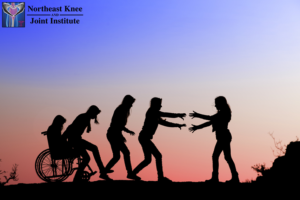Regenerative Medicine and Physical Therapy
Regenerative medicine is a fast-growing advancement in the medical field with no signs of slowing down. However, regenerative medicine can only help to a point if the body isn’t rehabilitated to regain function through physical therapy.
Physical therapy is the key to long-term relief.
Physical therapy is the treatment or management of physical disability, malfunction, or pain by exercise, massage, hydrotherapy, etc. without the use of medicines, surgery, or radiation. Simply stated, physical therapy is a treatment method that is used to restore the body’s function and movement due to injury or disease. The process of physical therapy can help the body heal correctly, and often can provide pain relief in the long run.
What can physical therapy help with?
- Tendon or ligament issues
- Muscle sprains or strains
- Arthritis conditions (osteoarthritis or rheumatoid arthritis)
- Sports-related injuries
- Accidental injuries or falls (auto, bike, or work-related)
- General rehabilitation of the muscles or joints
- Recovery after surgery or injury
The Whole Person Approach
Part of what makes Northeast Knee and Joint Institute so different from competitor healthcare offices is our unique Whole Person Approach to Healthcare. The Whole Person Approach offers a fresh perspective on recovery and the complete healing process. The idea is that by integrating conventional care with non-conventional therapies, we can address your pain and understand the complete workings of what additional factors may be directly or indirectly adding to your pain.
Physical therapy is only a small part of the whole approach to a full recovery, regardless of what led you to need it.
Our Whole Person Approach looks at more than just your pain, but into the factors that may be contributing risk factors. By addressing the full spectrum of lifestyle influences, we can truly understand how your life affects your condition.
- Physical
- Emotional
- Mental
- Social
- Spiritual
- Environmental
We aim to provide more than just pain relief.
When we think about pain, we forget that pain is a symptom. Pain occurs as a result of something that is happening in the body that shouldn’t be. When it comes to conditions that cause chronic pain, it is usually a sign that the body cannot compensate for something that is missing. When you think about osteoarthritis, it is a degenerative bone disease that wears down the cartilage, which cushions the joint. If you have chronic knee joint pain, it is your body trying to tell you that it cannot compensate for the missing cartilage and function normally.
Regenerative medicine can help!
When it comes to osteoarthritis, there are four types of injections that can provide relief; corticosteroids, hyaluronic acid, platelet-rich plasma, and stem cells. Any of these injection options can be helpful to manage the pain symptoms and contain regenerative features. Each option has their own pros and cons, although there are additional factors that need to be considered. While stem cells may sound like the best available option, the cost of the treatment itself may not fit into your budget.
However, the most promising results have been seen by patients that add physical therapy to their regenerative medicine treatment plan. Through physical therapy, the body is encouraged to regain its function and flexibility. With the help of our medical professionals, you can expect to get more out of your treatment plan.
Northeast Knee and Joint Institute Can Help
Northeast Knee and Joint Institute is made up of the area’s leading experts in regenerative medicine. Our founder and medical director, Dr. Edwin Roman, MD, Joseph Costa, CRNP, and the rest of our knowledgeable and experienced staff understand that there is so much more to a person than their pain. By mixing regenerative medicine and physical therapy, you can expect the most promising results. By utilizing our Whole Person Approach and our medical professionals, one consultation is all you’ll need to begin your road to recovery.

Northeast Knee and Joint Institute offer regenerative medicine options through injections. While some of these regenerative medicine injections may be covered by insurance, but you’ll need to consult with our office staff to verify if your insurance policy covers any or all of your procedure costs.
